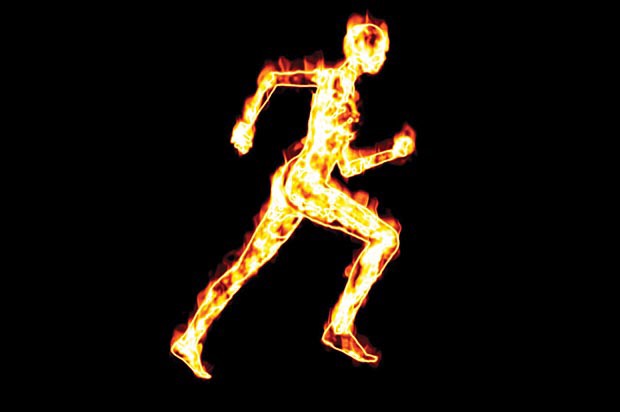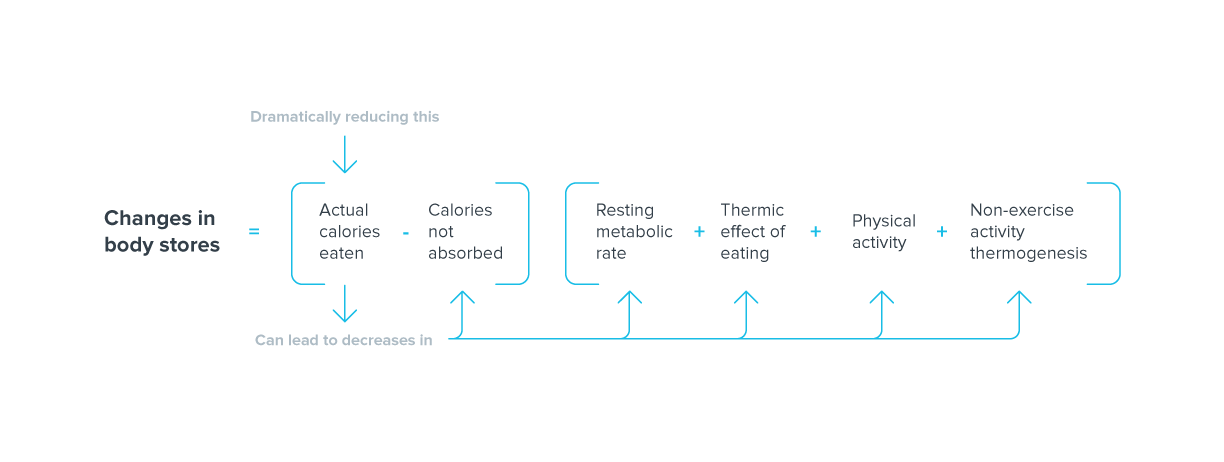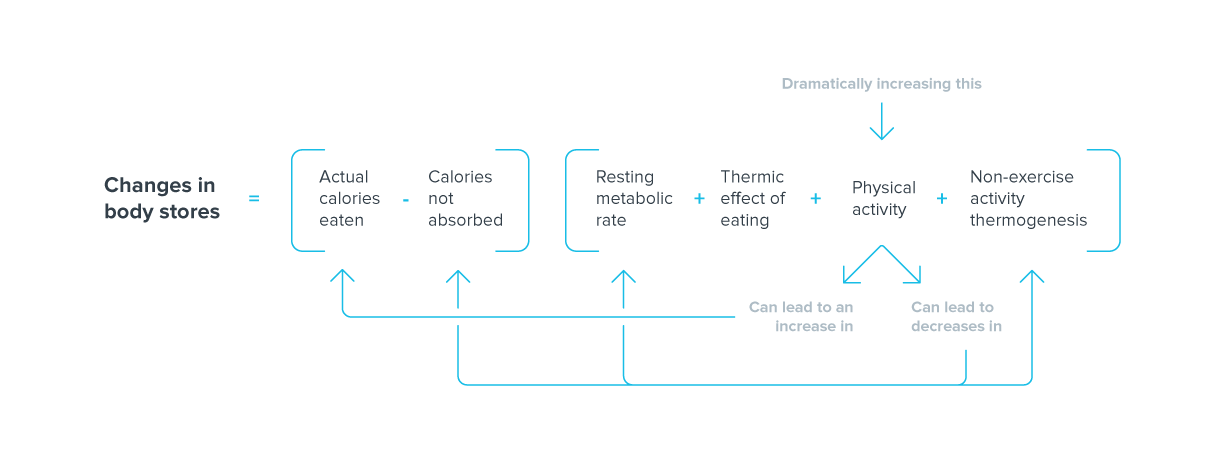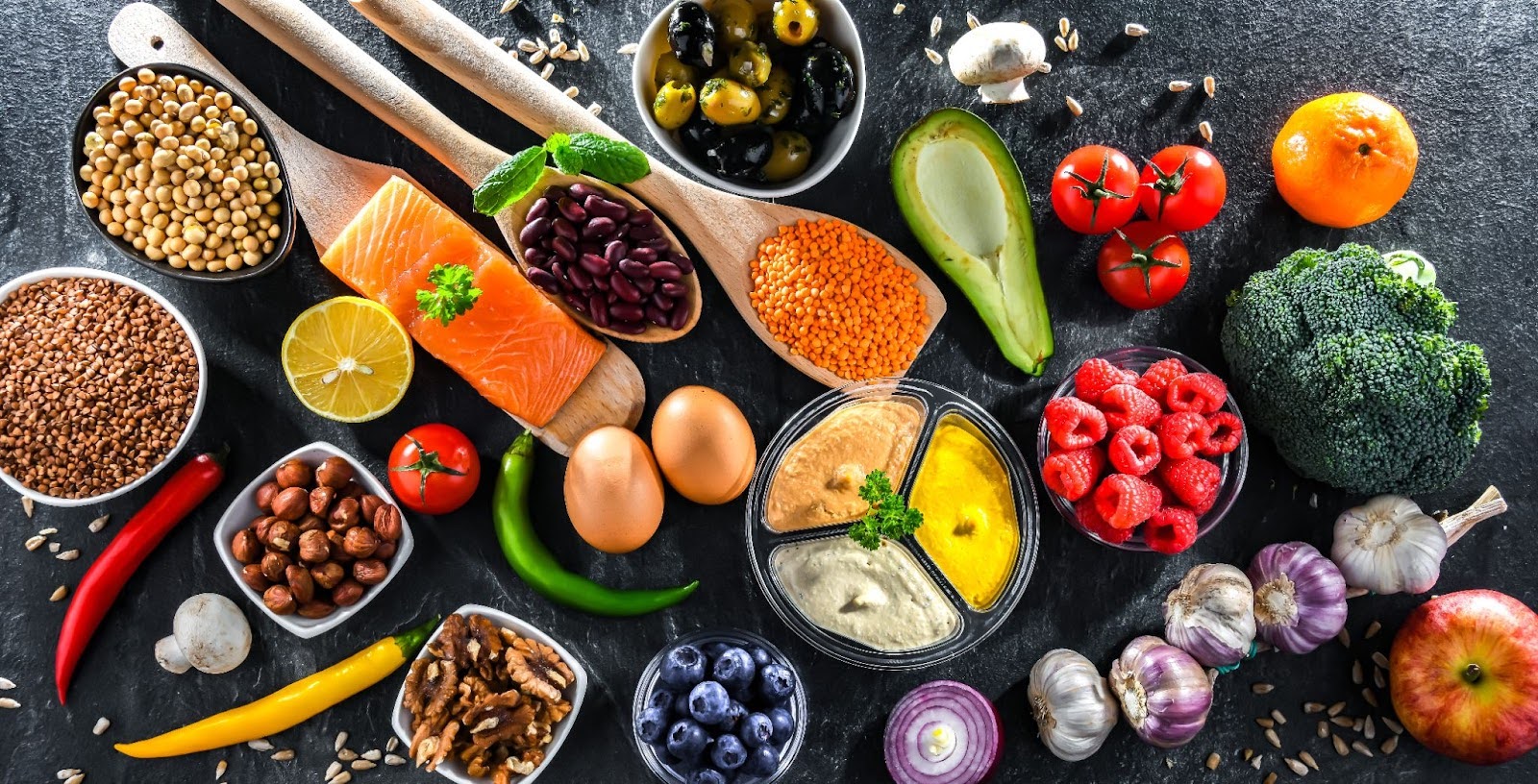
“Is my metabolism damaged?”
People ask this ALL the time… and the truth is, it’s super complicado! This subject is chronically changing its tune with each year I spend in this industry. A recent article from Precision Nutrition really gave a nice evidence based overview and FABULOUS equations that I will share with you. If you like science and math, this one’s for you.
Here goes….
Energy balance: The laws of physics still apply.
You need a certain amount of energy (in the form of calories) to stay alive, as well as to move around. You can get this energy from food, or you can retrieve it from stored energy (e.g. your fat tissue).
In theory:
If you eat less energy than you expend, you should lose weight.
If you do the opposite (i.e. eat more energy than you expend), you should gain weight.
In other words:

We use the term “body stores” deliberately as it represents the tissues available for breakdown (fat, muscle, organ, bone, etc) and excludes water (which can change body weight independently of energy balance).
This relationship between ‘energy in’ and ‘energy out’ is called the Energy Balance Equation, and it’s the most commonly accepted model for calculating a person’s energy balance and how much weight they’ll lose or gain over time.
While the Energy Balance Equation determines body weight, it doesn’t tell us much about body composition, which is influenced by things like sex hormone levels, macronutrient intake (especially protein), exercise style / frequency / intensity, age, medication use, genetic predisposition, and more.
Understandably, people get really frustrated and confused with the Energy Balance Equation when the numbers don’t seem to add up, or their results don’t match their expectations. (This is a good lesson, by the way, about the importance of adjusting your expectations to match observable reality.)
And it’s bloody annoying at times, am I right?
‘Energy in’ is trickier than you think.
Reason 1: The number of calories in a meal likely doesn’t match the number of calories on the labels or menu.
This might sound hard to believe, but it’s true… the way companies (and even the government) come up with calorie and nutrient estimates is incredibly complex, rather imprecise, and centuries-old. As a result, food labels can be off by as much as 20-25 percent.
And even if those food labels were correct:
Reason 2: The amount of energy a food contains in the form of calories is not necessarily the amount of energy we absorb, store, and/or use.
Remember that the food we eat has to be digested and processed by our unique bodies. The innumerable steps involved in digestion, processing, absorption, storage, and use, as well as our own individual physiological makeup , can all change the energy balance game.
So, for instance:
We absorb less energy from minimally processed carbohydrates, and fats, because they’re harder to digest.
We absorb more energy from highly processed carbohydrates and fats, because they’re easier to digest. (Think of it this way: The more “processed” a food is, the more digestion work is already done for you.)
For example, research has shown that we absorb more fat from peanut butter than from whole peanuts. The researchers found that almost 38 percent of the fat in peanuts was excreted in the stool, rather than absorbed by the body. Whereas seemingly all of the fat in the peanut butter was absorbed. Crazy right?!
In addition:
We often absorb more energy from foods that are cooked (and/or chopped, soaked, blended) because those processes break down plant and animal cells, increasing their bioavailability.
When eating raw starchy foods (like sweet potatoes), we absorb very few of the calories. After cooking, however, the starches are much more available to us, tripling the number of calories absorbed.
Interestingly, allowing starchy foods to then cool before eating them decreases the amount of calories we can extract from them again. (This is mostly due to the formation of resistant starches).
Finally:
We may absorb more or less energy depending on the types of bacteria in our gut.
Some people have larger populations of a Bacteroidetes (a species of bacteria), which are better at extracting calories from tough plant cell walls than other bacteria species.
Here’s an interesting example of this whole process at work. Recently, USDA researchers asked test subjects to consume 45 grams (about 1 ½ servings) of walnuts daily for three weeks.
What they found was that, on average, people only absorbed 146 of the 185 calories in the nuts. That’s 79 percent of the calorie content on the label.
In similar research, people also absorbed only 80 percent of the calories in almonds, and 95 percent of the calories in pistachios.
Beyond the average, there were individual differences: Some people absorbed more of the energy in the nuts, while some absorbed less (likely due to the differing populations of bacteria in their large intestines).
In the end, by eating a diet rich in whole, minimally processed foods, the number of calories you absorb can be significantly less than what you expect. Plus they require more calories to digest.
Conversely, you will absorb more calories by eating lots of highly processed foods, plus burn fewer calories in the digestive process. (In addition, highly processed foods are less filling, more energy dense, and more likely to cause overeating.)
Since the number of calories someone thinks they’re consuming could be off by 25 percent (or more), their carefully curated daily intake of 1,600 calories could really be 1,200… or 2,000.
This means:

As you can see, there’s a big margin of error for energy input, even if you’re a conscientious calorie counter. This doesn’t invalidate the Energy Balance Equation. It just means that if you want an accurate calculation, you probably have to live in a fancy metabolic lab… and I’m pretty sure you don’t. For most people, it’s not worth the effort.
There are four key parts to this complex system:
- Resting metabolic rate (RMR)
RMR is the number of calories you burn each day at rest, just to breathe, think, and live. This represents roughly 60 percent of your ‘energy out’ and depends on weight, body composition, sex, age, genetic predisposition, and possibly (again) the bacterial population of your gut.
A bigger body, in general, has a higher RMR.
For instance:
A 150-pound man might have an RMR of 1583 calories a day.
A 200-pound man might have an RMR of 1905 calories.
A 250-pound man might have an RMR of 2164 calories.
Crucially, RMR varies up to 15 percent from person to person. If you’re that 200-pound guy with an RMR of 1905 calories, another guy just like you on the next treadmill might burn 286 more (or fewer) calories each day with no more (or less) effort.
- Thermic effect of eating (TEE)
This may surprise you, but it takes energy to digest food. Digestion is an active metabolic process. (Ever had the “meat sweats” or felt hot after a big meal, especially one with lots of protein? That’s TEE.)
TEE is the number of calories you burn by eating, digesting, and processing your food. This represents roughly 5-10 percent of your ‘energy out’.
In general, you’ll burn more calories in your effort to digest and absorb protein (20-30 percent of its calories) and carbs (5-6 percent) than you do fats (3 percent).
And as noted before, you’ll burn more calories digesting minimally processed whole foods compared to highly processed foods.
- Physical activity (PA)
PA is the calories you burn from purposeful exercise, such as walking, running, going to the gym, gardening, riding a bike, Studio Sweating…etc. Obviously, how much energy you expend through PA will change depending on how much you intentionally move around.
- Non-exercise activity thermogenesis (NEAT).
NEAT is the calories you burn through fidgeting, staying upright, and all other physical activities except purposeful exercise. This, too, varies from person to person and day to day.
Here’s the entire equation:

When you try to outsmart your body and it outsmarts you back.
Even if all the variables in the final equation above were static, the Energy Balance Equation would be complicated enough. But things get crazy when you consider that altering any one of the variables causes adjustments in other, seemingly unrelated variables.
This is a good thing, of course. Our human metabolisms evolved to keep us alive and functioning when food was scarce. One consequence:
When ‘energy in’ goes down, ‘energy out’ goes down to match it. (You burn fewer calories in response to eating less).
Not in everybody. And not perfectly. But that’s how the system is supposed to work. That’s how our bodies avoid unwanted weight loss and starvation. It’s how humans have survived for 2 million years. The body fights to maintain homeostasis.
Likewise, when ‘energy in’ goes up, ‘energy out’ tends to go up too. (You burn more calories in response to eating more).
To illustrate this point, here’s how your body tries to keep your weight steady when you take in less energy and start to lose weight.
Thermic effect of eating goes down because you’re eating less.
Resting metabolic rate goes down because you weigh less.
Calories burned through Physical activity go down since you weigh less.
Non-exercise activity thermogenesis goes down as you eat less.
Calories not absorbed goes down and you absorb more of what you eat.
This response is particularly modest at first. But the adaptation really ramps up as you lose more weight. (Or if you’re starting out lean and trying to get super-lean).
Check out what this looks like:

In addition to these tangible effects on the equation, reducing actual calories eaten also causes hunger signals to increase, causing us to crave (and maybe eat) more.
The net effect leads to a much lower rate of weight loss than you might expect. In some cases, it could even lead to weight re-gain.
To add insult to injury, a rise in cortisol from the stress of dieting can cause our bodies to hold onto more water, making us feel “softer” and “less lean” than we actually are.
Interestingly, this is just one example of the amazing and robust response to trying to manipulate one variable (in this case, actual calories eaten). There are similar responses when trying to manipulate each of the other variables in the equation.
For example, research suggests that increasing Physical activity above a certain threshold (by exercising more) can trigger:
Increased appetite and more actual calories eaten
Decreased calories not absorbed as we absorb more of what we eat
Decreased RMR
Decreased NEAT
In this case, here’s what the equation would look like:

Scientists at the National Institutes of Health have studied the data from people who have lost weight, and created a mathematical model that represents how weight and fat loss actually happens in the real world.
We can play with it, using the Precision Nutrition Weight Loss Calculator. I tried it out and it was pretty close to what I estimated!
What to do with all this info…
- Say “interesting” and move on. OR
- Use it to make lifestyle changes to get a specific outcome (i.e. lose body fat). If this is you read on:
- Eat when you’re hungry and stop when you’re full.
- Eat a wide variety of fruits, vegetables, quality carbs, and healthy fats. Vegetables are loaded with vitamins, minerals, phytonutrients, water, and fiber to help you fill up during meals, stay full between meals, keep you healthy, and recover from your workouts.
- As your fat loss progresses, you will need to maintain and perhaps increase resistance training and mix it up. Studio Sweat is PERFECTION for that.
- Understand that this is complex. So many things influence what, why, and when we choose to eat. Too often, eating and body size / fatness are blamed on lack of knowledge, lack of willpower/discipline, or laziness. In reality, food intake and body composition are governed by a mix of physiological, biological, psychological, social, economical, and lifestyle influences, along with individual knowledge or beliefs.
- Remember that body composition change should be slow. Like, give yourself at least 6 weeks to see a change. I like to say, “sneak up” on your body due to its primitive adaptive responses.
- Do a mixture of resistance, cardiovascular, and recovery activity. Cat is excellent at coaching on this. She influences me on the regular. Resistance training helps you maintain vital muscle mass, burn calories, and improve glucose tolerance. Cardiovascular exercise improves the health of your cardiovascular system, helps you expend energy, and can improve recovery. But don’t overdo either one. Recovery work (e.g. foam rolling, walking, yoga) helps you maintain consistency and intensity with resistance and cardio training, making them more effective. And it helps to decrease stress (lowering cortisol), which also helps you lose body fat and keep it off. Aim for 3-5 hours per week of purposeful activity.
- Find ways to increase NEAT. Get a stand-up or treadmill desk, fidget, pace when on the phone, take the stairs, park farther away from where you’re going, etc. These small increases in activity can make a big difference, and can account for hundreds of daily calories.
- Develop a solid nightly sleep routine and manage your stress. Sleep is just as important to your success as nutrition and activity levels. Don’t pretend that you can get by with less. It simply isn’t true. Often, when people lower their stress, they lose a lot of body water. Then they also notice that they may have lost fat too. (Plus, they may discover that chronic inflammation goes down — another win.) This includes mental and emotional stress. Research on cognitive dietary restraint (i.e. worrying and stressing out about food) shows that constantly and negatively fixating on what you eat (or don’t) can have the same unhealthy effect as actually dieting stringently. Yet we need some stress to actually help with progress and growth, so find your stress sweet spot.
- Have some self-compassion. MOST IMPORTANT. There are going to be meals or days where you don’t eat as you “should”. Get rid of the “should” statements because they harm you and your efforts. Food is neutral. It’s just food. Research actually shows that self-compassion and flexible eating is associated with lower BMI and a healthier body weight, lower self-reported calorie intake, less anxiety and stress, and a better relationship with food. And make sure that the body you really want aligns with the life you really enjoy. Understand what is required to reach different levels of body composition. Consider the impact that will have on your life, and choose accordingly.
Now my brain hurts… but I wanted to put this all in here for you to reference in case you find yourself in the diet tornado and you need some grounding.
Toodles!
MJ
Resource: Precision Nutrition









Comments - 0